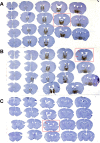Reduced infarct size in neuroglobin-null mice after experimental stroke in vivo
- PMID: 22901501
- PMCID: PMC3487987
- DOI: 10.1186/2040-7378-4-15
Reduced infarct size in neuroglobin-null mice after experimental stroke in vivo
Erratum in
-
Correction: Reduced infarct size in neuroglobin-null mice after experimental stroke in vivo.Exp Transl Stroke Med. 2013 Aug 8;5(1):10. doi: 10.1186/2040-7378-5-10. Exp Transl Stroke Med. 2013. PMID: 23926921 Free PMC article. No abstract available.
Abstract
Background: Neuroglobin is considered to be a novel important pharmacological target in combating stroke and neurodegenerative disorders, although the mechanism by which this protection is accomplished remains an enigma. We hypothesized that if neuroglobin is directly involved in neuroprotection, then permanent cerebral ischemia would lead to larger infarct volumes in neuroglobin-null mice than in wild-type mice.
Methods: Using neuroglobin-null mice, we estimated the infarct volume 24 hours after permanent middle cerebral artery occlusion using Cavalieri's Principle, and compared the infarct volume in neuroglobin-null and wild-type mice. Neuroglobin antibody staining was used to examine neuroglobin expression in the infarct area of wild-type mice.
Results: Infarct volumes 24 hours after permanent middle cerebral artery occlusion were significantly smaller in neuroglobin-null mice than in wild-types (p < 0.01). Neuroglobin immunostaining of the penumbra area revealed no visible up-regulation of neuroglobin protein in ischemic wild-type mice when compared to uninjured wild-type mice. In uninjured wild-type mice, neuroglobin protein was seen throughout cortical layer II and sparsely in layer V. In contrast, no neuroglobin-immunoreactive neurons were observed in the aforementioned layers of the ischemia injured cortical area, or in the surrounding penumbra of ischemic wild-type mice. This suggests no selective sparing of neuroglobin expressing neurons in ischemia.
Conclusions: Neuroglobin-deficiency resulted in reduced tissue infarction, suggesting that, at least at endogenous expression levels, neuroglobin in itself is non-protective against ischemic injury.
Figures




Similar articles
-
Neuroglobin over expressing mice: expression pattern and effect on brain ischemic infarct size.PLoS One. 2013 Oct 1;8(10):e76565. doi: 10.1371/journal.pone.0076565. eCollection 2013. PLoS One. 2013. PMID: 24098534 Free PMC article.
-
SB 234551 selective ET(A) receptor antagonism: perfusion/diffusion MRI used to define treatable stroke model, time to treatment and mechanism of protection.Exp Neurol. 2008 Jul;212(1):53-62. doi: 10.1016/j.expneurol.2008.03.011. Epub 2008 Mar 25. Exp Neurol. 2008. PMID: 18462720
-
Neuroglobin, a novel target for endogenous neuroprotection against stroke and neurodegenerative disorders.Int J Mol Sci. 2012;13(6):6995-7014. doi: 10.3390/ijms13066995. Epub 2012 Jun 7. Int J Mol Sci. 2012. PMID: 22837676 Free PMC article. Review.
-
Human copper-zinc superoxide dismutase transgenic mice are highly resistant to reperfusion injury after focal cerebral ischemia.Stroke. 1994 Jan;25(1):165-70. doi: 10.1161/01.str.25.1.165. Stroke. 1994. PMID: 8266365
-
Protection by neuroglobin and cell-penetrating peptide-mediated delivery in vivo: a decade of research. Comment on Cai et al: TAT-mediated delivery of neuroglobin protects against focal cerebral ischemia in mice. Exp Neurol. 2011; 227(1): 224-31.Exp Neurol. 2011 Sep;231(1):1-10. doi: 10.1016/j.expneurol.2011.05.010. Epub 2011 May 18. Exp Neurol. 2011. PMID: 21620833 Review.
Cited by
-
Neuroglobin deficiency increases seizure susceptibility but does not affect basal behavior in mice.J Neurosci Res. 2022 Oct;100(10):1921-1932. doi: 10.1002/jnr.25105. Epub 2022 Jul 13. J Neurosci Res. 2022. PMID: 35822521 Free PMC article.
-
Neuroglobin boosts axon regeneration during ischemic reperfusion via p38 binding and activation depending on oxygen signal.Cell Death Dis. 2018 Feb 7;9(2):163. doi: 10.1038/s41419-017-0260-8. Cell Death Dis. 2018. PMID: 29416029 Free PMC article.
-
Neuroglobin, a Factor Playing for Nerve Cell Survival.Int J Mol Sci. 2016 Oct 31;17(11):1817. doi: 10.3390/ijms17111817. Int J Mol Sci. 2016. PMID: 27809238 Free PMC article. Review.
-
The anti-apoptotic role of neuroglobin.Cells. 2012 Nov 23;1(4):1133-55. doi: 10.3390/cells1041133. Cells. 2012. PMID: 24710547 Free PMC article.
-
Prodromal Alzheimer's Disease: Constitutive Upregulation of Neuroglobin Prevents the Initiation of Alzheimer's Pathology.Front Neurosci. 2020 Dec 3;14:562581. doi: 10.3389/fnins.2020.562581. eCollection 2020. Front Neurosci. 2020. PMID: 33343276 Free PMC article.
References
-
- Gjedde A, Magistretti P. In: Youmans neurological surgery. Volume 1. 6. Winn HR, editor. Elsevier, Philadelphia, PA; 2011. Cellular mechanisms of brain energy metabolism; pp. 123–146.
-
- Moens L, Dewilde S. Globins in the brain. Nature. 2000;407:461–462. - PubMed
LinkOut - more resources
Full Text Sources
Molecular Biology Databases
Miscellaneous

